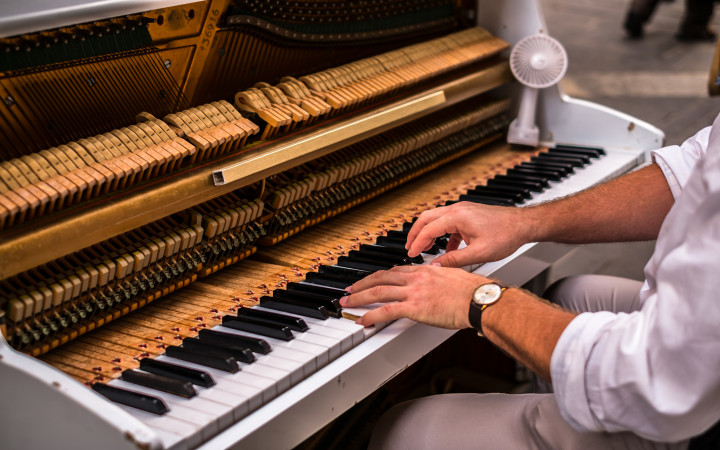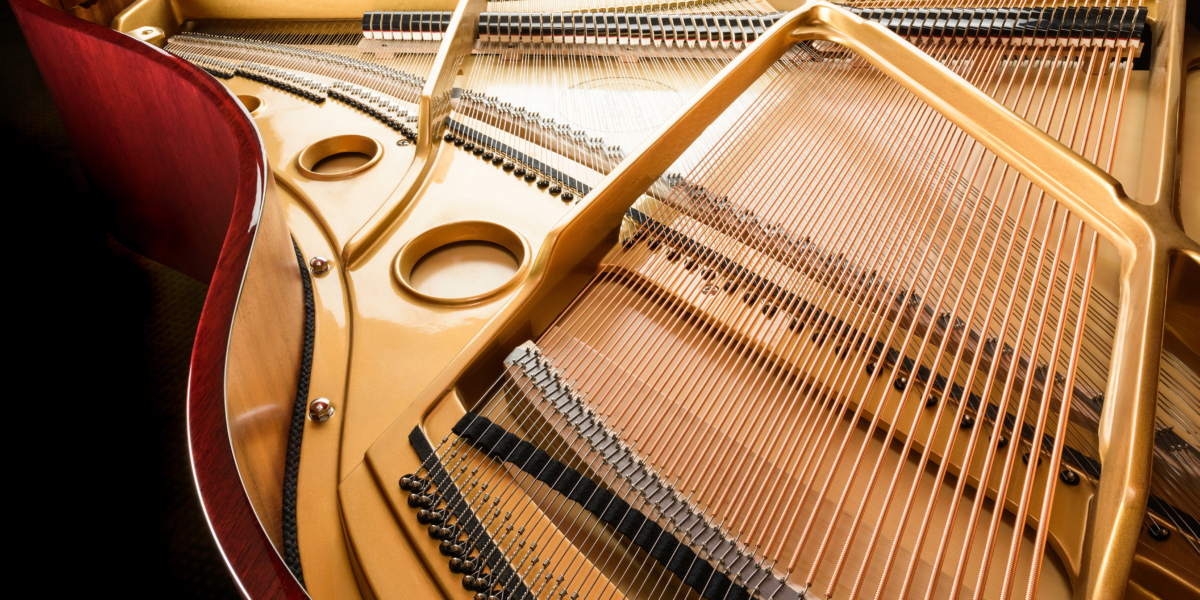Yes, the piano is a string instrument; it produces sound through strings. It is classified as a chordophone by musicologists.
The piano stands as an iconic instrument that has shaped the world of music for centuries. Its versatility crosses genres from classical to jazz and pop. The mechanics of a piano involve hammers inside the instrument striking strings when the keys are pressed, creating vibrations that turn into the rich, resonant sounds we associate with this beloved instrument.
While often thought of as a keyboard instrument due to its array of keys, its string-based sound production confirms its status as a string instrument. The piano’s design combines the intricacy of string tension and the immediacy of keyboard control to make it accessible for both beginners and virtuosos alike, truly making it a centerpiece in the musical instrument realm.

Credit: www.wqxr.org
The Dual Nature Of The Piano
An enigma of the musical world, the piano sports a captivating blend of characteristics. It stands at the crossroads of two families: strings and percussion. This dual nature bestows upon the piano a versatility unseen in other instruments, making it unique in the realm of music-making.
The Hammer-string Mechanism
The heart of the piano’s duality lies in its hammer-string mechanism. When a pianist presses a key, a felt-covered hammer strikes a string inside the piano. This action produces a vibration, which then translates into the rich and resonant sound we associate with this majestic instrument. Boldly put, the piano acts as a string instrument at this juncture.
Let’s delve into the specifics:
- Keys: Pressing them initiates sound.
- Hammers: They hit the strings to create vibrations.
- Strings: These vibrated strings produce the piano’s sound.
- Soundboard: It amplifies the sound from the strings.
Percussive And Melodic Roles
With such a mechanism, the piano deftly assumes two roles. In one breath, it acts as a percussive instrument. The hammers striking the strings mirror the action of a drummer hitting a drum, giving the piano its rhythm and beat.
Simultaneously, the piano takes on a melodic role. It can produce a long series of notes that blend into harmonious melodies, much like a violin or a cello. This blend of roles allows pianists to express a full spectrum of musical ideas—from the thumping of a bass line to the gentle weep of a lyrical passage.
| Percussive Qualities | Melodic Qualities |
|---|---|
|
|
Indeed, the piano’s capacity to simultaneously fulfill the roles of both string and percussion instruments is a testament to its intricate and marvelous design. Music enthusiasts often marvel at this chameleon-like ability that allows the piano to blend seamlessly with various ensembles or stand out as a solo powerhouse.

Credit: wonderopolis.org
Historical Evolution Of The Piano
The piano, beloved by many, has a rich history. Its evolution is fascinating, weaving together advances in technology, craftsmanship, and music. This journey transformed the way we create and enjoy music today. Let’s delve into the remarkable historical evolution of the piano and discover its origins and development.
Early Keyboard Instruments
The story of the piano begins with its predecessors. The first keyboard instruments appeared centuries ago. They were the ancestors of the modern piano.
- Clavichord: An early instrument with a delicate sound, used mainly for practice and small rooms.
- Harpsichord: Known for its brighter tone, the harpsichord was popular in Renaissance and Baroque music.
- Organ: The organ, with its powerful pipes, filled cathedrals with resonant tones, shaping the sounds of sacred spaces.
These instruments laid the groundwork for the pianoforte, which would revolutionize music.
Development Of The Modern Piano
In the early 18th century, the quest for dynamic expression in music led to the birth of the piano we know today. The term pianoforte reflects its ability to play notes both softly (piano) and loudly (forte).
| Year | Event | Inventor |
|---|---|---|
| 1700s | Invention of the Pianoforte | Bartolomeo Cristofori |
| 1800s | Upright Pianos Developed | John Isaac Hawkins |
| 1900s | Enhancements in Sound and Durability | Various |
Each period introduced enhancements in sound, size, and design. The modern piano emerged, capable of a wide range of volumes and tones.
Classification Of Instruments
The classification of instruments serves as a foundation for understanding how we organize and identify the multitude of musical devices around us. As we dive into the enchanting world of music, it is crucial to grasp where each instrument fits in the grand tapestry of sound. Let’s explore the cornerstones of string instruments and unravel the piano’s place within these classifications.
Characteristics Of String Instruments
String instruments, also known as chordophones, produce sound through the vibration of strings. These vibrations are often amplified by a resonant body, which is an integral part of the instrument. Here are defining features that categorize an instrument as a string:
- Strings: They possess one or more strings.
- Vibration: Sound emanates through string vibration.
- Resonation: A body enhances the sound.
- Methods: You can pluck, bow, or strike the strings.
Piano Under The Hornbostel-sachs System
The Hornbostel-Sachs system classifies instruments based on how they produce sound. Under this system, the piano’s classification can sometimes befuddle enthusiasts and professionals alike.
| ID | Instruments | Classification |
|---|---|---|
| 314.122 | Piano | Chordophone-Keyboard |
Pianos have strings that sound when struck by hammers. Thus, they fall into the chordophone category. However, their operation through a keyboard assigns them to a specific subset known as keyboard chordophones.

Credit: www.hellosimply.com
Playing Techniques
Exploring the Piano’s Playing Techniques reveals the unique blend of string and percussion characteristics this versatile instrument holds. To fully appreciate the piano’s capabilities, understanding the subtleties of technique is essential. Let’s dive into the artistry behind the keys.
Striking The Keys
Mastering the piano begins with striking the keys. Every touch influences the tone and volume. It’s the pianist’s fingerprint on the music.
- Light touches create soft, whisper-like notes.
- Firm strikes bring out a bold, commanding presence.
Achieve different sounds by altering your approach. Explore from gentle caressing to emphatic pounding.
String Resonance And Pedaling
Sustain and Damper pedals shape the piano’s voice. They control how strings vibrate and interact with each other.
| Pedal | Function | Effect on Sound |
|---|---|---|
| Sustain Pedal | Keeps notes ringing | Creates a rich, full texture |
| Damper Pedal | Stops string vibration | Produces clear, precise notes |
Engage pedals to weave a tapestry of sound. Add depth or clarity as the music requires.
Comparison With Other String Instruments
Let’s dive into how the piano stands in the orchestra of string instruments. We compare it with violin and guitar families. We explore how it makes its unique sounds.
Violin And Guitar Families
Violin and guitar strings vibrate when played. They can be plucked or bowed. This creates their music. Pianos also have strings inside. But they make sound differently. Here’s how they compare:
- Violins need a bow to make sound. Or you can pluck them with fingers.
- Guitars are mostly plucked or strummed with fingers or a pick.
- Pianos have hammers inside. They hit the strings when you press the keys.
Materials make a difference too. Violins and guitars use wooden bodies to resonate sound. Pianos are large with wooden frames. They have a cast iron plate to hold string tension.
Unique Aspects Of Piano Sound Production
The piano is truly special. Below we list what makes a piano’s sound one-of-a-kind:
| Aspect | Detail |
|---|---|
| Hammers | Pianos use felt-covered hammers to hit the strings. |
| Keys | Each key is a lever that makes a hammer strike a string. |
| Dampers | Dampers stop the string when you release a key. |
| String Length | The strings are of varying lengths to produce different pitches. |
Each piano key controls one or more strings. Higher notes may have three strings per note. This adds to the piano’s rich sound. Pianos also let you sustain notes with pedals. This keeps the strings vibrating after you’ve hit the key.
The Role Of The Piano In Music Ensembles
The piano boasts a unique ability to blend melodies, harmonies, and rhythms. Its versatility shines in varied music ensembles. The piano’s role stretches from a standalone marvel to a harmonic bedrock within groups. Its vibrant tones and dynamic range enrich music genres across the board.
Solo And Accompaniment
As a solo instrument, the piano stands out for its rich, full-bodied sound. Pianists perform intricate pieces showcasing their skill and the instrument’s wide range.
- Solo recitals offer audiences an intimate experience with the performer and the music.
- In accompaniment, pianists support and enhance others’ musical lines.
Singers and instrumentalists rely on the piano. It provides rhythm and harmony, allowing soloists to shine.
Orchestral And Chamber Music
In larger ensembles, the piano plays a dual role.
- Orchestral settings often use pianos for color and emphasis.
- Chamber groups like trios and quartets deploy the piano as a central voice.
The instrument’s versatility is on full display whether in a symphony orchestra or a smaller chamber context.
Are Piano and Harp Considered Similar Instruments in Terms of Music Sheets?
When it comes to using piano sheet music for harp, there are similarities and differences between the two instruments. While both instruments use the same staff notation and clefs, harp music typically requires specific notation for pedals and lever changes, making it different from piano music sheets.
Frequently Asked Questions Of Is The Piano A String Instrument
What Family Of Instruments Does The Piano Belong In?
The piano belongs to the keyboard family of musical instruments. It is classified as a stringed instrument as well.
What Is A Piano Like String Instrument?
A piano-like string instrument is referred to as a harpsichord. It produces sound through strings that are plucked rather than struck.
Is Piano A Part Of The String Family?
Yes, the piano falls under the string family due to its stringed mechanism producing sound when hammers strike the strings.
Is Keyboard A Wind Or String Instrument?
A keyboard is neither a wind nor a string instrument; it falls under the category of percussion instruments if acoustic, like a piano, or electronic instruments if it’s a synthesizer or digital piano.
Conclusion
The piano dazzles as a captivating hybrid of string and percussion elements. Its hammers strike strings, creating the melodic charm that defines its uniqueness. Whether in a concert hall or a cozy living room, the piano’s dual identity enriches our musical landscape, inviting both players and listeners into a world of harmonic beauty.
